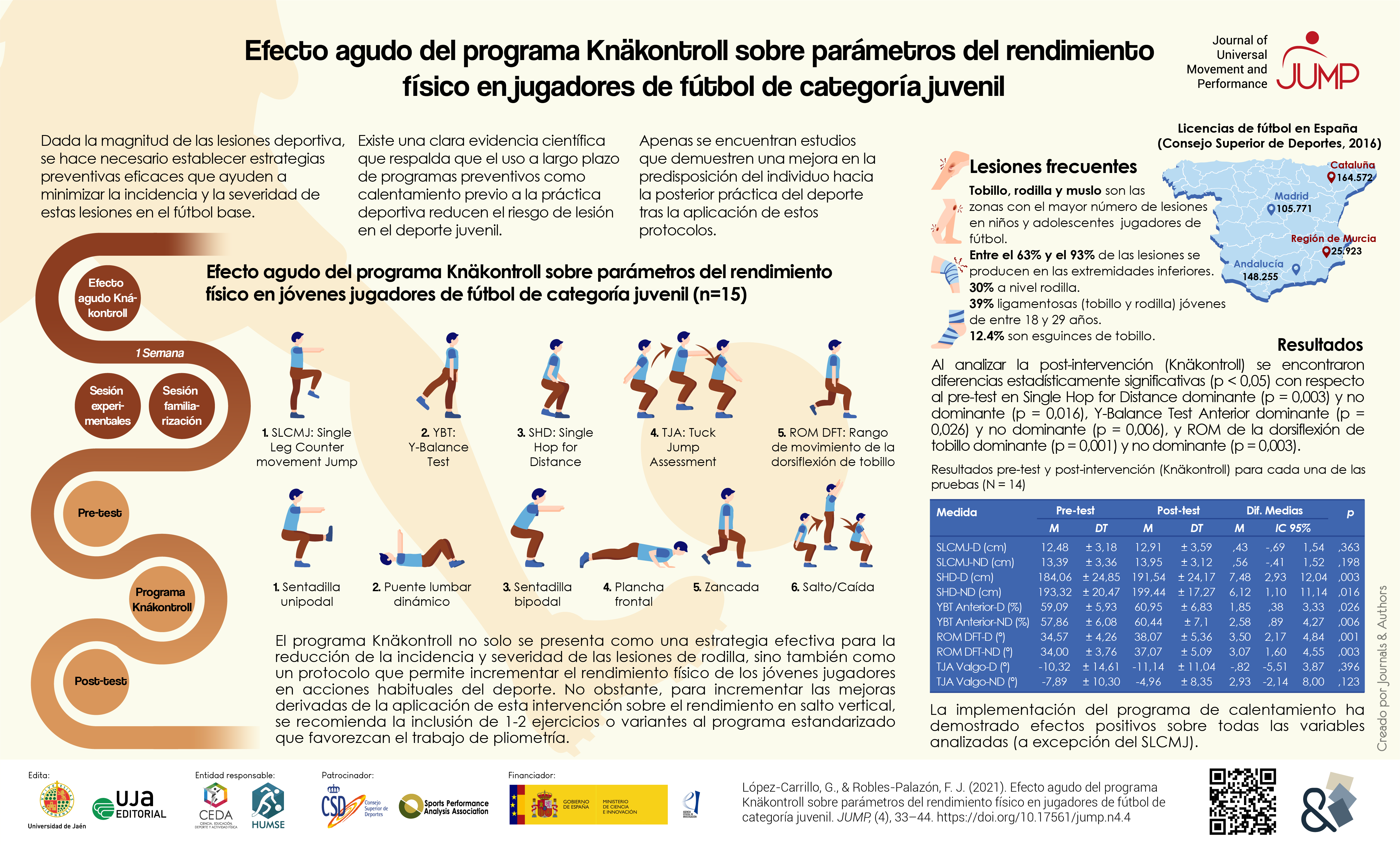Efecto agudo del programa Knäkontroll sobre parámetros del rendimiento físico en jugadores de fútbol de categoría juvenil
DOI:
https://doi.org/10.17561/jump.n4.4Palabras clave:
adolescente, prevención, riesgo de lesión, calentamiento, neuromuscularResumen
El fútbol es un deporte que, por la alta exigencia física que requiere, lleva asociado un elevado riesgo de lesión. Dada la magnitud del problema, los investigadores han optado por diseñar estrategias preventivas que ayuden a minimizar la incidencia de lesión en este deporte. Estas estrategias se han organizado como programas de calentamiento previo a la participación en el deporte. Sin embargo, la evidencia sobre el efecto agudo de estas intervenciones sobre parámetros del rendimiento físico es escasa. Por tanto, el objetivo del presente estudio fue analizar el efecto agudo del programa Knäkontroll (nivel B) sobre parámetros del rendimiento físico en jugadores de fútbol de categoría juvenil. Para ello, se utilizó un diseño cuasi-experimental pre-test y post-test, empleando la estabilidad dinámica de la extremidad inferior (Y-Balance Test), la cinemática de la caída en salto vertical (Tuck Jump Assessment [TJA]), el rango de movimiento articular de la dorsiflexión de tobillo (ROM-Sport), la distancia de salto horizontal unilateral (Single-Legged Hop Tests), y la altura de salto vertical unilateral (Single Leg Countermovement Jump [SLCMJ]) como principales medidas del rendimiento físico. Los resultados mostraron un incremento significativo del rendimiento para todas las variables tras la implementación del programa Knäkontroll, a excepción de la altura en el SLCMJ y la cinemática en el TJA. En conclusión, el programa Knäkontroll se presenta como una estrategia adecuada para su aplicación como calentamiento previo a la práctica del fútbol. No obstante, la inclusión de ejercicios (o variantes) adicionales que trabajen el componente pliométrico podría contribuir a la mejora del desempeño en el salto vertical.
Referencias
Abenza, L., Olmedilla, A., Ortega, E., & Ato, M. (2010). Análisis de la relación entre el estado de ánimo y las conductas de adherencia en deportistas lesionados. Anales de Psicología, 26(1), 159. https://www.redalyc.org/pdf/167/16713758019.pdf
Afonso, J., Ramirez-Campillo, R., Moscão, J., Rocha, T., Zacca, R., Martins, A., ... & Clemente, F. M. (2021). Strength training is as effective as stretching for improving range of motion: A systematic review and meta-analysis. Healthcare, 9(4), 427. https://doi.org/10.3390/healthcare9040427
Ayala, F., Calderón-López, A., Delgado-Gosálbez, J.C., Parra-Sánchez, S., Pomares-Noguera, C., Hernández-Sánchez, S., ... & Croix, M.D.S. (2017). Acute effects of three neuromuscular warm-up strategies on several physical performance measures in football players. PloS one, 12(1), e0169660. https://doi.org/10.1371/journal.pone.0169660
Bahr, R., & Maehlum, S. (2007). Lesiones deportivas: diagnóstico, tratamiento y rehabilitación. Madrid: Editorial Médica Panamericana.
Bizzini, M., Impellizzeri, F. M., Dvorak, J., Bortolan, L., Schena, F., Modena, R., & Junge, A. (2013). Physiological and performance responses to the “FIFA 11+”(part 1): is it an appropriate warm-up?. Journal of Sports Sciences, 31(13), 1481-1490. https://doi.org/10.1080/02640414.2013.802922
Cejudo, A., Robles-Palazón, F.J., Ayala, F., De Ste Croix, M., Ortega-Toro, E., Santonja-Medina, F., & Sainz de Baranda, P. (2019). Age-related differences in flexibility in soccer players 8-19 years old. PeerJ, 7, e6236. https://doi.org/10.7717/2Fpeerj.6236
Cejudo, A., Sainz de Baranda, P., Ayala, F., De Ste Croix, M., & Santonja-Medina, F. (2020). Assessment of the Range of Movement of the Lower Limb in Sport: Advantages of the ROM-SPORT I Battery. International Journal of Environmental Research and Public Health, 17(20), 7606. https://doi.org/10.3390/ijerph17207606
Dingenen, B., & Gokeler, A. (2017). Optimization of the return-to-sport paradigm after anterior cruciate ligament reconstruction: a critical step back to move forward. Sports Medicine, 47(8), 1487-1500. https://doi.org/10.1007/s40279-017-0674-6
Dingenen, B., Malfait, B., Vanrenterghem, J., Robinson, M. A., Verschueren, S. M. P., & Staes, F. F. (2015). Can two-dimensional measured peak sagittal plane excursions during drop vertical jumps help identify three-dimensional measured joint moments? The Knee, 22(2), 73-79. https://doi.org/10.1016/j.knee.2014.12.006
Drawer, S., & Fuller, C. W. (2002). Evaluating the level of injury in English professional football using a risk based assessment process. British Journal of Sports Medicine, 36(6), 446-451. https://doi.org/10.1136/2Fbjsm.36.6.446
Fuller, C. W., Ekstrand, J., Junge, A., Andersen, T. E., Bahr, R., Dvorak, J., ... & Meeuwisse, W. H. (2006). Consensus statement on injury definitions and data collection procedures in studies of football (soccer) injuries. Scandinavian Journal of Medicine & Science in Sports, 16(2), 83-92. https://bjsm.bmj.com/content/40/3/193
Gaspar, Í. G. (2017). Estudio de la relación entre la dorsiflexión de tobillo y las asimetrías en el crossover hop test for distance en jugadores de fútbol (Tesis de pregrado). Zaragoza: Universidad San Jorge.
Gribble, P. A., Hertel, J., & Plisky, P. (2012). Using the Star Excursion Balance Test to assess dynamic postural-control deficits and outcomes in lower extremity injury: a literature and systematic review. Journal of Athletic Training, 47(3), 339-357. https://doi.org/10.4085/1062-6050-47.3.08
Gribble, P. A., Terada, M., Beard, M. Q., Kosik, K. B., Lepley, A. S., McCann, R. S., ... & Thomas, A. C. (2016). Prediction of lateral ankle sprains in football players based on clinical tests and body mass index. The American Journal of Sports Medicine, 44(2), 460-467. https://doi.org/10.1177/0363546515614585
Hawkins, R. D., & Fuller, C. W. (1999). A prospective epidemiological study of injuries in four English professional football clubs. British Journal of Sports Medicine, 33(3), 196-203. https://doi.org/10.1136/2Fbjsm.33.3.196
Herrero, H., Salinero, J. J., & Del Coso, J. (2014). Injuries among Spanish male amateur soccer players: a retrospective population study. The American Journal of Sports Medicine, 42(1), 78-85. https://doi.org/10.1177/0363546513507767
Kiani, A., Hellquist, E., Ahlqvist, K., Gedeborg, R., & Byberg, L. (2010). Prevention of soccer-related knee injuries in teenaged girls. Archives of Internal Medicine, 170(1), 43-49.
King, T. (2020). An exploration into the assessment of hip extension strength and its importance for performance in professional soccer (Tesis de doctorado). Liverpool John Moores University).
Krustrup, P., Aagaard, P., Nybo, L., Petersen, J., Mohr, M., & Bangsbo, J. (2010). Recreational football as a health promoting activity: a topical review. Scandinavian Journal of Medicine & Science in Sports, 20(s1), 1-13. https://doi.org/10.1111/j.1600-0838.2010.01108.x
LaBella, C. R., Huxford, M. R., Grissom, J., Kim, K.-Y., Peng, J., & Christoffel, K. K. (2011). Effect of Neuromuscular Warm-up on Injuries in Female Soccer and Basketball Athletes in Urban Public High Schools: Cluster Randomized Controlled Trial. Archives of Pediatrics and Adolescent Medicine, 165(11), 1033–1040. https://doi.org/10.1001/archpediatrics.2011.168
Larruskain, J., Lekue, J. A., Diaz, N., Odriozola, A., & Gil, S. M. (2018). A comparison of injuries in elite male and female football players: A five‐season prospective study. Scandinavian Journal of Medicine & Science in Sports, 28(1), 237-245. https://doi.org/10.1111/sms.12860
Llana-Belloch, S., Pérez-Soriano, P., & Lledó-Figueres, E. (2010). La epidemiología en el fútbol: una revisión sistemática. Revista Internacional de Medicina y Ciencias de la Actividad Física y del Deporte, 10(37), 22-40. http://cdeporte.rediris.es/revista/revista37/artfutbol130.htm
Logerstedt, D., Grindem, H., Lynch, A., Eitzen, I., Engebretsen, L., Risberg, M. A., Axe, M. J., & Snyder-Mackler, L. (2012). Single-Legged Hop Tests as predictors of self-reported knee function after anterior cruciate ligament reconstruction. The American Journal of Sports Medicine, 40(10), 2348-2356. https://doi.org/10.1177/0363546512457551
Maffulli, N., Longo, U. G., Gougoulias, N., Loppini, M., & Denaro, V. (2010). Long-term health outcomes of youth sports injuries. British Journal of Sports Medicine, 44(1), 21–25. https://doi.org/10.1136/bjsm.2009.069526
Mandelbaum, B. R., Silvers, H. J., Watanabe, D. S., Knarr, J. F., Thomas, S. D., Griffin, L. Y., … Garrett, Wi. J. (2005). Effectiveness of a Neuromuscular and Proprioceptive Training Program in Preventing the Incidence of Anterior Cruciate Ligament Injuries in Female Athletes: 2-year follow up. The American Journal of Sports Medicine, 33(7), 1–8. https://doi.org/10.1177/0363546504272261
Masach, J. (2008). Estructura condicional del juego del futbol y evaluación de la condición física como base para la metodología en la preparación física. Material de Estudio Máster Universitario de preparación física en el fútbol (Primera ed.). Universidad de Castilla La Mancha, Real Federación Española de Fútbol.
Mayo, M., Seijas, R., & Alvarez, P. (2014). Structured neuromuscular warm-up for injury prevention in young elite football players. Revista Española de Cirugía Ortopédica y Traumatología (English Edition), 58(6), 336-342. https://doi.org/10.1016/j.recote.2014.09.004
Morton, S. K., Whitehead, J. R., Brinkert, R. H., & Caine, D. J. (2011). Resistance training vs. static stretching: effects on flexibility and strength. The Journal of Strength & Conditioning Research, 25(12), 3391-3398. https://doi.org/10.1519/jsc.0b013e31821624aa
Mufty, S., Bollars, P., Vanlommel, L., Van Crombrugge, K., Corten, K., & Bellemans, J. (2015). Injuries in male versus female soccer players: epidemiology of a nationwide study. Acta Orthopaedica Belgica, 81(2), 289-295.
Myer, G. D., Ford, K. R., & Hewett, T. E. (2008). Tuck jump assessment for reducing anterior cruciate ligament injury risk. Athletic Therapy Today, 13(5), 39-44.
Noyes, F. R., Barber, S. D., & Mangine, R. E. (1991). Abnormal lower limb symmetry determined by function hop tests after anterior cruciate ligament rupture. The American Journal of Sports Medicine, 19(5), 513-518. https://doi.org/10.1177/036354659101900518
Orchard, J., & Hoskins, W. (2007). For debate: consensus injury definitions in team sports should focus on missed playing time. Clinical Journal of Sport Medicine, 17(3), 192-196. https://doi.org/10.1097/jsm.0b013e3180547527
Plisky, P. J., Rauh, M. J., Kaminski, T. W., & Underwood, F. B. (2006). Star Excursion Balance Test as a predictor of lower extremity injury in high school basketball players. Journal of Orthopaedic & Sports Physical Therapy, 36(12), 911-919. https://doi.org/10.2519/jospt.2006.2244
Read, P. J., Oliver, J. L., Myer, G. D., Farooq, A., Croix, M. D. S., & Lloyd, R. S. (2020). Utility of the anterior reach Y-Balance test as an injury risk screening tool in elite male youth soccer players. Physical Therapy in Sport, 45, 103-110. https://doi.org/10.1016/j.ptsp.2020.06.002
Robles-Palazón, F. J., Pomares-Noguera, C., Ayala, F., Hernández-Sánchez, S., Martínez-Romero, M. T., Sainz de Baranda, P., & Wesolek, I. (2016). Acute and chronic effects of the FIFA 11+ on several physical performance measures in adolescent football players. European Journal of Human Movement, 36, 116-136. https://www.eurjhm.com/index.php/eurjhm/article/view/373
Robles-Palazón, F. J., Ruiz-Pérez, I., Oliver, J. L., Ayala, F., & Sainz de Baranda, P. (2021). Reliability, validity, and maturation-related differences of frontal and sagittal plane landing kinematic measures during drop jump and tuck jump screening tests in male youth soccer players. Physical Therapy in Sport, 50, 206-216. https://doi.org/10.1016/j.ptsp.2021.05.009
Robles-Palazón, F., & Sainz de Baranda, P. (2017). Programas de entrenamiento neuromuscular para la prevención de lesiones en jóvenes deportistas. Revisión de la literatura. SPORT TK-Revista EuroAmericana de Ciencias del Deporte, 6(2), 115-126. https://doi.org/10.6018/300451
Romero-Moraleda, B., Cuéllar, Á., González, J., Bastida, N., Echarri, E., Gallardo, J., & Paredes, V. (2017). Revisión de los factores de riesgo y los programas de prevención de la lesión del ligamento cruzado anterior en fútbol femenino: propuesta de prevención. RICYDE. Revista Internacional de Ciencias del Deporte, 13(48). https:// doi.org/10.5232/ricyde2017.04803
Rössler, R., Junge, A., Bizzini, M., Verhagen, E., Chomiak, J., Aus der Fünten, K., ... & Faude, O. (2018). A multinational cluster randomised controlled trial to assess the efficacy of ‘11+ Kids’: a warm-up programme to prevent injuries in children’s football. Sports Medicine, 48(6), 1493-1504. https://doi.org/10.1007/s40279-017-0834-8
Śliwowski, R., Grygorowicz, M., Wieczorek, A., & Jadczak, Ł. (2018). The relationship between jumping performance, isokinetic strength and dynamic postural control in elite youth soccer players. The Journal of Sports Medicine and Physical Fitness, 58(9), 1226-33. https://doi.org/10.23736/s0022-4707.17.07289-9
Soligard, T., Myklebust, G., Steffen, K., Holme, I., Silvers, H., Bizzini, M., ... & Andersen, T. E. (2008). Comprehensive warm-up programme to prevent injuries in young female footballers: cluster randomised controlled trial. British Medical Journal, 337, a2469. https://doi.org/10.1136/bmj.a2469
Waldén, M., Atroshi, I., Magnusson, H., Wagner, P., & Hägglund, M. (2012). Prevention of acute knee injuries in adolescent female football players: cluster randomised controlled trial. British Medical Journal, 344, e3042. https://doi.org/10.1136/bmj.e3042
Yu, B., & Garrett, W. E. (2007). Mechanisms of non-contact ACL injuries. British Journal of Sports Medicine, 41(suppl 1), i47-i51. https://doi.org/10.1136/2Fbjsm.2007.037192
Zahínos, J., González, C., & Salinero, J. (2010). Estudio epidemiológico de las lesiones. Los procesos de adaptación y prevención de la lesión de ligamento cruzado anterior en el fútbol profesional. Journal of Sport and Health Research. 2(2), 139-150.

Descargas
Publicado
Número
Sección
Licencia
Derechos de autor 2021 Guillermo López-Carrillo, Francisco Javier Robles-Palazón

Esta obra está bajo una licencia internacional Creative Commons Atribución 4.0.















